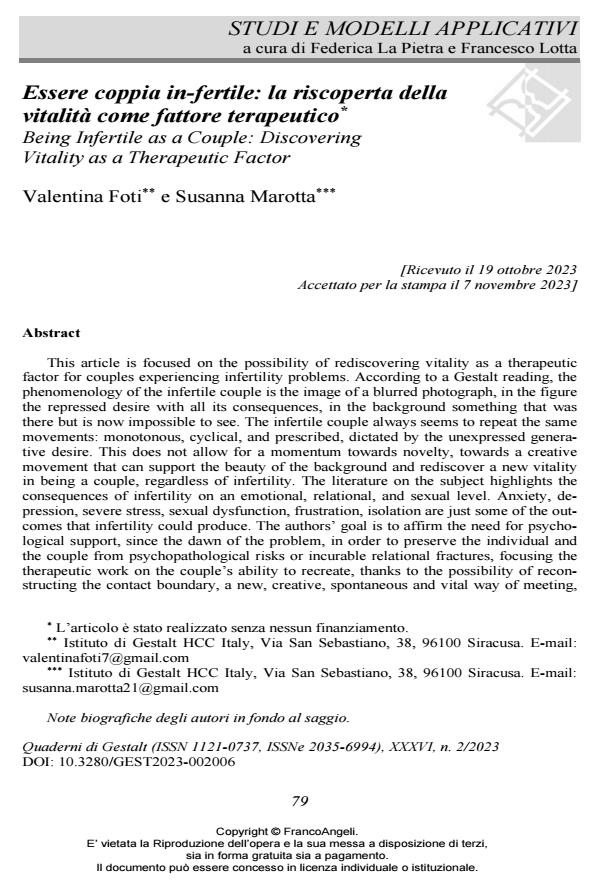Being Infertile as a Couple: Discovering Vitality as a Therapeutic Factor
Journal title QUADERNI DI GESTALT
Author/s Valentina Foti, Susanna Marotta
Publishing Year 2024 Issue 2023/2 Language Italian
Pages 13 P. 79-91 File size 172 KB
DOI 10.3280/GEST2023-002006
DOI is like a bar code for intellectual property: to have more infomation
click here
Below, you can see the article first page
If you want to buy this article in PDF format, you can do it, following the instructions to buy download credits

FrancoAngeli is member of Publishers International Linking Association, Inc (PILA), a not-for-profit association which run the CrossRef service enabling links to and from online scholarly content.
This article is focused on the possibility of rediscovering vitality as a therapeutic factor for couples experiencing infertility problems. According to a Gestalt reading, the phenomenology of the infertile couple is the image of a blurred photograph, in the figure the repressed desire with all its consequences, in the background some-thing that was there but is now impossible to see. The infertile couple always seems to repeat the same movements: monotonous, cyclical, and prescribed, dictated by the unexpressed generative desire. This does not allow for a momentum towards novelty, towards a creative movement that can support the beauty of the background and re-discover a new vitality in being a couple, regardless of infertility. The literature on the subject highlights the consequences of infertility on an emotional, relational, and sexual level. Anxiety, depression, severe stress, sexual dysfunction, frustration, iso-lation are just some of the outcomes that infertility could produce. The authors’ goal is to affirm the need for psychological support, since the dawn of the problem, in order to preserve the individual and the couple from psychopathological risks or in-curable relational fractures, focusing the therapeutic work on the couple’s ability to recreate, thanks to the possibility of reconstructing the contact boundary, a new, creative, spontaneous and vital way of meeting, with the confidence of being able to stand in pain in the figure, and the certainty of being able to cling to a safe back-ground. A good therapeutic work can help the couple to face the diagnostic path and the medically assisted procreation treatments, a very delicate and painful phase for the couple, both physically and emotionally. The article is underlined the importance of rediscovering the vitality of the infertile couple, through good therapeutic work in the background, supporting the personality function and unlocking the id function, as well as enhancing the sense of agency and effectiveness. The rediscovery of the vital impulse could represent a profitable therapeutic factor both to face the problem in a new way and to create new energy understood as a push towards change and growth.
Keywords: Vitality, infertile couple, medically assisted procreation, motherhood, sexuality
- Ameruoso E. (2010). La coppia tra genitorialità e generatività: l’esperienza adolescenziale nella manifestazione dell’infertilità psicogena. Rivista di Psicologia clinica, 1: 49-61.
- Alberoni F. (1979). Innamoramento e Amore. Milano: Garzanti Editore.
- Auhagen-Stephanos U. (1993). La maternità negata. La paura inconscia di un figlio desiderato. Torino: Bollati Boringhieri.
- Baragetti E., Palmero E. (2021). Il tempo della speranza. Quaderni di Gestalt, XXXIV, 2: 59-70. DOI: 10.3280/GEST2021-002005
- De Camillis B. (2010). Strategie di coping nelle coppie infertili. Psicoterapeuti in-formazione, 5: 109-132.
- Froggio G. (2000). Bambino mio sognato. Psicologia e psicoterapia della sterilità. Milano: San Paolo.
- Gaio F., Abbiati V., Broglia D., De Micheli A., Gambini F., Maccagnoni S., Pezzini F. Caverzasi E. (2010). Aspetti psichiatrici dell’infertilità: analisi della letteratura. Bollettino della Società Medico Chirurgica di Pavia, 123, 3:613-619.
- Hocaoglu C. (2018). The Psychosocial Aspect of infertility. In: Sheriff D.S., ed., Infertility, Assisted Reproductive Technologies and Hormone Assays. Londra, UK: IntechOpen, pp. 65-78.
- Masquelier G. (2014). Il ciclo dell’interazione sessuale. Quaderni di Gestalt, XXVII, 1: 93-102. DOI: 10.3280/GEST2014-00101
- Ministero della Salute (2008). Decreto dell’11 aprile 2008. Linee guida in materia di procreazione medicalmente assistita. Gazzetta Ufficiale n. 101 del 30/04/2008.
- Mione M. (2019). L’incarnarsi del “tra” nella co-creazione dell’essere due. Sessualità e processi corporei di coppia in psicoterapia della Gestalt. Quaderni di Gestalt, XXXII, 1: 29-56. DOI: 10.3280/GEST2019-001003
- Persico A.S., Fianco A. (2021). La coppia come organismo vivo: un’esperienza di contatto. Quaderni di Gestalt, XXXIV, 2: 71-86. DOI: 10.3280/GEST2021-00200
- Righetti P.L. (2001). I vissuti psicologici nella Procreazione Medicalmente Assistita: interventi e protocolli integrati medico-psicologici. Contraccezione Fertilità Sessualità, 28, 3: 159-166.
- Sheriff D.S., ed. (2018). Infertility, Assisted Reproductive Technologies and Hormone Assays. Londra, UK: IntechOpen.
- Simonelli C. (1996). Diagnosi e trattamento delle disfunzioni sessuali. Milano: FrancoAngeli.
- Spagnuolo Lobb M. (2011). Il now-for-next. La psicoterapia della Gestalt raccontata nella società post-moderna. Milano: FrancoAngeli.
- Spagnuolo Lobb M. (2012). Lo sviluppo polifonico dei domini. Verso una prospettiva evolutiva della psicoterapia della Gestalt. Quaderni di Gestalt, XXV, 2: 31-50. DOI: 10.3280/GEST2012-00200
- Spagnuolo Lobb M. (2014). Le esperienze depressive in psicoterapia della Gestalt. Quaderni di Gestalt, XXVII, 2: 57-80. DOI: 10.3280/GEST2014-00200
- Spagnuolo Lobb M. (2020a). Dalla perdita delle funzioni-io ai “passi di danza” tra psicoterapeuta e paziente. Fenomenologia ed estetica del contatto nel campo psicoterapeutico. Quaderni di Gestalt XXXIII, 1: 21-40.
- Spagnuolo Lobb M. (2020b). Fenomenologia e riconoscimento estetico della “danza” tra psicoterapeuta e paziente: un esempio clinico. Quaderni di Gestalt XXXIII, 1: 41-56. DOI: 10.3280/GEST2020-00100
- Spagnuolo Lobb M. (2021). Il lavoro sullo sfondo, l’estetica e la “danza”. La conoscenza relazionale estetica e la reciprocità. In: Spagnuolo Lobb M., Cavaleri P.A., a cura di, Psicopatologia della situazione. La psicoterapia della Gestalt nei campi clinici delle relazioni umane. Milano: FrancoAngeli, pp. 25-51.
- Vanni C., Valoriani V., Odorisio F. (2010). Rappresentazioni genitoriali e adattamento di coppia nella procreazione medicalmente assistita. Infanzia e adolescenza, 9, 3: 158-169.
Valentina Foti, Susanna Marotta, Essere coppia in-fertile: la riscoperta della vitalità come fattore terapeutico in "QUADERNI DI GESTALT" 2/2023, pp 79-91, DOI: 10.3280/GEST2023-002006